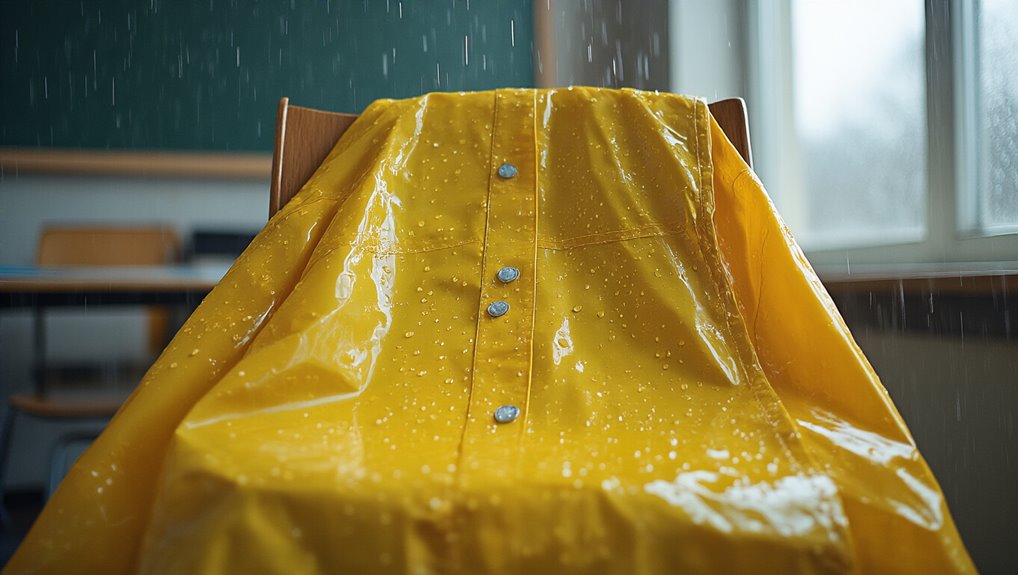I learned how a yellow raincoat turns simple plastic into a reliable weather shield by watching water bead, run off, and avoid seams. I explain how materials like polyurethane or PVC block moisture, how DWR finishes raise droplet contact angles, and why taped or heat-welded seams plus high hydrostatic head stop leaks. I also show how microporous membranes balance breathability with waterproofing. Keep going and you’ll uncover practical tests and care tips that restore performance.
Key Takeaways
- Explain how polyurethane and PVC coatings create low-permeability fabrics that block liquid water while remaining flexible.
- Describe seam techniques (heat-welded, taped) that prevent needle-hole leaks and improve overall waterproofing.
- Show how DWR surface treatments increase droplet contact angle, causing water to bead and shed from the jacket.
- Compare breathability metrics (MVTR, RET) and membrane types that let vapor escape but stop liquid rain.
- Demonstrate hydrostatic head and tensile tests that quantify a raincoat’s resistance and long-term durability.
I still remember the first time I zipped up a yellow raincoat and stepped into a city that seemed to rinse itself clean—rain drummed on the hood, taxi lights blurred into watercolor, and strangers moved with the quiet purpose of people who’d learned how to live in wet weather. That jacket taught me more than dryness; it became a lesson in materials science. I watched water bead and run off, and I wanted to know why. The answer lives in polymers, surface energy, and clever fabrication techniques that turn ordinary plastics into effective weather shields.
A yellow raincoat, rain beading and running off, turned a rainy city into a lesson in everyday materials science
When I peeled back the label and studied the seams, I found evidence of design choices rooted in measured properties. Plastics like polyurethane and PVC are common because they combine low permeability with flexibility. Lab tests quantify permeability in units like g/m²·24h; lower values mean less moisture passes through. Manufacturers choose coatings with sufficiently low water vapor transmission rates for intended climates.
At the same time, tensile strength and elongation data determine whether a fabric resists tearing while folding into a pocket—practical metrics you’ll find on technical sheets.
Seam construction mattered more than I expected. Heat-welded seams or taped seams create barriers at the weakest points. In controlled tests, taped seams reduce leakage far more than stitched seams alone, since needle holes compromise continuity. You can measure seam performance with hydrostatic head tests, which indicate the pressure a fabric withstands before water penetration. A higher hydrostatic head correlates with better rain resistance under wind-driven conditions.
Surface treatments also play a measurable job. Durable water repellent (DWR) finishes raise the contact angle of droplets so beads form and shed. Contact-angle measurements give objective data; angles above 90 degrees typically indicate hydrophobic behavior. Over time, abrasion and oils degrade DWR, which is why reproofing restores performance—a reproducible effect you can see in repeat tests.
Ventilation and breathability balance is another engineered compromise. Membranes with micropores, like PTFE-based laminates, allow vapor molecules to pass while blocking liquid water. Breathability is reported as RET or MVTR values; lower RET and higher MVTR correspond to more comfort during activity. Design integrates vents, pit zips, or porous back panels to improve real-world vapor transport beyond lab numbers.
Seeing the raincoat work isn’t magic; it’s applied science validated by metrics. When I walk through drizzle now, I feel confidence backed by measurable performance: coatings that repel, membranes that stop ingress while letting sweat escape, and seams that hold under pressure. That combination explains why a simple plastic raincoat can keep you dry and comfortable in weather that would otherwise soak you through.
Frequently Asked Questions
How Do Microplastics From Raincoats Affect Soil and Waterways?
They harm soil and waterways: I’ve seen microplastics alter soil structure, carry toxins, and clog waterways, reducing filtration and harming microbes, invertebrates and fish; I’ll cite studies and propose fixes so we actually clean up.
Can Raincoats Be Safely Recycled at Home?
No — I can’t safely recycle most raincoats at home; waterproof coatings and mixed materials need industrial processes. I recommend checking local textile recycling, municipality programs, or manufacturer take-back schemes to avoid contamination and microplastic release.
Do Biodegradable Raincoats Fully Break Down Outdoors?
They mostly don’t fully break down outdoors; I wish they vanished like morning mist. I rely on studies showing many need industrial composting—specific heat, microbes, and time—so check labels and composting facilities for proper disposal.
How Do Additives in Plastic Raincoats Impact Human Health?
Additives in plastic raincoats can harm health: I’d warn you they may off‑gas or leach phthalates, flame retardants, or heavy metals, potentially causing hormonal disruption, respiratory irritation, or long‑term toxicity—choose tested, low‑chemical options.
Are There Standards for Measuring Raincoat Environmental Footprints?
Yes — I know standards exist: life cycle assessment (LCA) protocols, ISO 14040/44, and ecolabel criteria (e.g., EU Ecolabel). I’ll help you compare their scope, metrics, and data quality for raincoat footprints.

